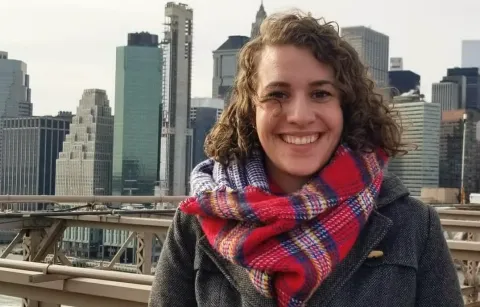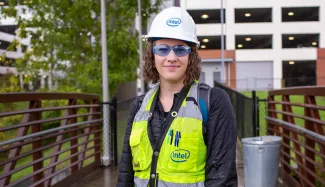"If you're thinking about engineering or if someone you respect suggests that you might be good in engineering, give it a try."

Mariah Newman
- Degree:
- Bachelor of Applied Science
- Grad year: 2016
- Program:
- Campus: Okanagan
Job title as of April 2023: Mechanical Staff Engineer at Intel Corporation
Why did you want to study engineering?
I thought I wanted to apply for undergraduate programs in physics and philosophy – in hindsight, I now see that engineering often combines the two! It was my high school physics teacher who pointed out to me that I would likely thrive in engineering, which was a program I didn’t know much about. It was just what I needed to hear at the time – he knew me and better than I knew myself.
What were some highlights of your undergraduate experience?
My first two big group projects were definite highlights. The first was developing a can crusher to crush cans horizontally rather than vertically and the second was building a balsa wood hovercraft. Both of these were hands-on projects from designing through to building and testing, and they confirmed for me that engineering was a good program choice for me.
Mechanical Engineering Projects Can Crusher Project Balsa Wood Hovercraft
Tell us about your career since graduation.
For my next co-op placement I was quite strategic about finding a position in the US and I got a job at Intel as a facilities engineer intern. At the end of that placement, Intel offered me a job and I have been here ever since.
I started as a facilities engineer working with technicians, equipment vendors and tradespeople to manage and support the expansion of industrial heating and cooling water and vacuum systems at a site. In my current role, I support Intel’s chip manufacturing facilities and data centres across the US. This involves strategy and budget development for a group of about 600 people. I also run a training program for our group in a global setting.
The training program is really my baby. When I was working in the facility, people would always come to my manager and I for help. It was great, but it also took a lot of time. My manager and I thought we could do something more strategic – to basically set up a business boot camp where we would offer different courses and get people to volunteer to teach them on a specific schedule.
That started four years ago and about 25 volunteers lead about 60 classes each month on a range of topics, from business processes to technical topics, like the one I created a few years ago on fire-tube boilers.

What would you like to achieve as an engineer?
Looking ahead to the next three or five years I’d like to continue setting up more repeatable processes and advancing strategy within my team. I’d also like to deepen my understanding of Intel’s R&D and integrating that at our sites.




